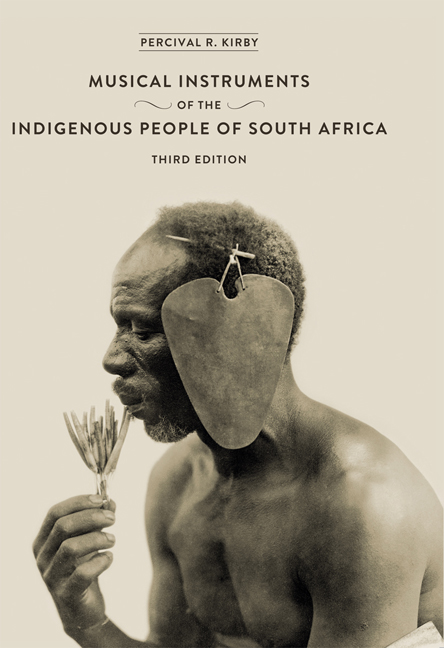Book contents
- Frontmatter
- Dedication
- Map
- Contents
- Foreword
- Preface to First Edition
- Preface to Second Edition
- Acknowledgements
- Acknowledgements to Third Edition
- List of Illustrations
- 1 Rattles and Clappers
- 2 Drums
- 3 Xylophones and ‘Sansas’
- 4 Bull-Roarers and Spinning-Disks
- 5 Horns and Trumpets
- 6 Whistles, Flutes, and Vibrating Reeds
- 7 Reed-Flute Ensembles
- 8 The ‘Gora’, A Stringed-Wind Instrument
- 9 Stringed Instruments
- 10 Bushman and Hottentot Violins and The ‘Ramkie’
- 11 Some European Instruments Played By Natives
- Appendix
- Addenda
- Index
9 - Stringed Instruments
Published online by Cambridge University Press: 21 April 2018
- Frontmatter
- Dedication
- Map
- Contents
- Foreword
- Preface to First Edition
- Preface to Second Edition
- Acknowledgements
- Acknowledgements to Third Edition
- List of Illustrations
- 1 Rattles and Clappers
- 2 Drums
- 3 Xylophones and ‘Sansas’
- 4 Bull-Roarers and Spinning-Disks
- 5 Horns and Trumpets
- 6 Whistles, Flutes, and Vibrating Reeds
- 7 Reed-Flute Ensembles
- 8 The ‘Gora’, A Stringed-Wind Instrument
- 9 Stringed Instruments
- 10 Bushman and Hottentot Violins and The ‘Ramkie’
- 11 Some European Instruments Played By Natives
- Appendix
- Addenda
- Index
Summary
THERE are eleven types of stringed instruments used by the native peoples of South Africa. At least two were deliberately copied from European prototypes, and I shall consider them separately. The remaining nine will here be dealt with, not according to the relative simplicity of their construction, but according to the relative complexity of the sound produced from them.
These stringed instruments would appear to have originated, directly or indirectly, from the bow of the hunter, and it is interesting to find in this country clear evidence of such development at different stages. As Balfour has pointed out ‘writers of all ages have drawn attention to the musical note emitted by the bowstring when released in shooting, and dwell upon the delight which it afforded to the archer's ear’, and there can be no doubt that such delight was shared by those of the South African peoples who used the bow. A further stage in the realization of the musical possibilities of the hunting-bow would be achieved when it occurred to the hunter to tap his bow-string with an arrow, thus applying a new method of sound-production to the string. This practice has been observed among the Kalahari Bushmen. A hunter, after having made a kill, would, to pass the time while waiting for his companions to come up to him, lightly tap his bow-string with an arrow. But there exists evidence of an extension of this practice which is of considerable importance to musical history. A ‘Bushman’ rock-painting was discovered by Stow in the Maluti Mountains of Basutoland. He made a copy of it, but did not publish it, and it was not made available for general study until 1930, when it appeared in the collection of Stow's copies of rock-paintings, published by the Oxford University Press under the editorship of Miss Dorothea Bleek. Miss Bleek made an extensive tour of South Africa in order to check Stow's drawings from the originals, but unfortunately was unable to find this particular one. We must therefore rely on Stow's accuracy until the original comes to light, if it has not been destroyed.
- Type
- Chapter
- Information
- The Musical Instruments of the Indigenous People of South Africa , pp. 258 - 331Publisher: Wits University PressPrint publication year: 2013



